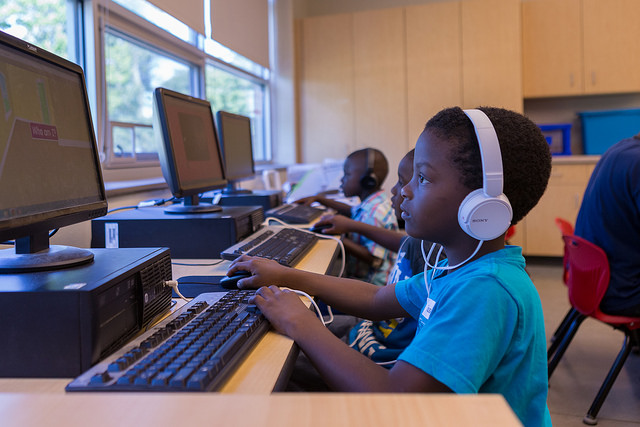Strategies for Direct Service
 A church/ministry interested in getting involved with education and child advocacy should engage in a direct action asset identification process, which entails assessing what you have and matching it with the type of work you are seeking to do. These are important questions for your congregation/ministry to ask, discuss, and consider.
A church/ministry interested in getting involved with education and child advocacy should engage in a direct action asset identification process, which entails assessing what you have and matching it with the type of work you are seeking to do. These are important questions for your congregation/ministry to ask, discuss, and consider.
Physical Resources
- What kind of space do you have, and what types of resources do you have in that space? (i.e. furniture, computers, gymnasium, stage area, kitchen, bathrooms, etc.) This is important to ask for a myriad of reasons. For example, early childhood programming in the morning or afterschool may require the provision and storage of food.
- If your property is not up to date or is not suitable for this work (or if you do not have property), what spaces might your community provide? (i.e. parks, libraries, community centers, etc.)
- How many people can be allowed in your space? Most churches or organizations that have space available will usually have the capacity displayed publically or on record.
- Are your building and grounds safe and up to code? (Do you have fire alarms, extinguishers? First aid posters? Evacuation diagrams?)
- Are you or can you be considered a recognized Safe Place (http://nationalsafeplace.org/) for children?
- Do you have a public area with a bulletin board?
- Do you have good functioning technology with access to computer(s) and social media?
- Can you provide transportation? (i.e. church van, access to transportation services)
- Are you in an area that is easily accessible via public transportation?
- Where are you located? How close is your site to schools (colleges/universities included), libraries, the police station, or other churches and organizations? These questions are critical in assessing what types of partnerships can be made. Pastors and congregation members can form relationships and build networks that will be valuable to your ministry by attending events like back-to-school night or special programs at the local college or university. Hosting a community event in your own space is another way to build relationships within the community.
- What state and city programs related to youth, arts, education, family, health, and child advocacy are available in your community?
Human Resources
- Before you reinvent the wheel, see what organizations are doing around you. Is there a ministry that is already doing education well but is in need of space? Can you partner with a church, ministry, or agency that is already engaged in this work?
- Who attends your church, and how can they be helpful in this process? (Lawyers, administrators, schoolteachers, nurses, police officers, social workers, grant writers, city workers, etc.) Your congregation may have a treasure trove of folks who have experience in a myriad of occupations that can be advantageous to the work of child advocacy and education.
- Who is in your community, and how can you build relationships with them? (Judges, business owners, neighborhood organizations, etc.)
- Do the parents of the children you intend to serve live in the community? If not, where do they live?
- Do you have the resources to employ youth workers?
- Can you do this work with volunteers? Sometimes, the local college, university, or seminary can help by making student interns available.
- Are you involved in mission/church growth programs? (i.e. Missional church, New Beginnings, etc.) Many of these programs can be used to begin to integrate church members and neighborhood organizations into the work.
Financial/Administrative Resources
- To whom in your church are those who run this ministry accountable? It if often helpful to create a board or another group separate from the session or regular governing bodies to oversee this ministry.
- Do you have a good accountability system in place? Who will ensure that accountability is maintained?
- Are you eligible for grants/initiatives and/or other funding sources? Programs that do not have religious content (such as tutoring or arts programs) are often eligible for grants from civic and even governmental programs and entities. If your program serves children without regard to religious affiliation and doesn’t include specifically Christian content, it may be eligible for these grants.
- Are members of your congregation members in community councils, organizations? (i.e. arts councils, gender and issue based groups, etc.)
- Does your presbytery have any initiatives or money available?
- If you do not already, start collecting the Pentecost Offering (see “Pentecost 101” in this toolkit). The Pentecost Offering is a viable way to help support the work that you seek to do; forty percent of the money collected stays with your congregation to support these types of ministries. For more information about the Pentecost Offering, visit: pcusa.org/pentecost.
Personnel/Policy Issues to Address
- It is important for any church/ministry doing this type of work to have policy and personnel practices (job descriptions, reporting, chain of command, etc.) in place. Does your church/ministry have precedent for these types of policies?
- Do you have a child protection policy? In addition to sexual harassment and misconduct policies, most presbyteries require churches to have these in place. Do you have a system or process in addressing these issues? (i.e. Board, Trustees, Personnel Committee, etc.)
- It is essential that anyone working with children or youth under the age of 18 complete a comprehensive background check. Some online services provide quick results for a fee (Praesidium, LexisNexis). Many churches or ministries will already have a procedure in place. Check with those responsible for Christian Education.
- Check with the church’s insurance and have a conversation with Session, Board, or governing body about understanding coverage options in relationship to young people.
- Below are two key PC(USA) resources that will help you develop policies and practices to protect the safety of all children served by your direct action ministry:
► See index of topics at right under “Learn More” to read the toolkit online or download the entire toolkit below.
